St. Martin of Tours Church is the oldest Church in Haverfordwest, situated in the oldest part of the County Town, and was probably built in 1102 AD. The Mediaeval Churchyard contains a War Memorial for the men of her Parish who fell in both World Wars. The memorial was unveiled by the Mayor, W. G. Rowlands, on Sunday 6 November 1919, following a memorial service in the church, Many thanks to Brian Body for sending in the photograph of the memorial, and for the transcription of the names which appear on it.
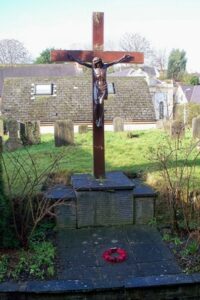
The Great War, 1914-1918
Alfred Arran, Private, 2001, Welsh Regiment. Alfred was the son of John and Mary Arran, of 41, Quay Street, Haverfordwest, and the Husband of Sarah Arran, of 5, Maeryerngran Cottages, Priory Street, Carmarthen. He enlisted at Haverfordwest into the Welsh Regiment, and was posted to the 8th Battalion, Welsh Regiment, which was attached to 40 Brigade, 13th (Western) Division. Towards the end of February the entire Division concentrated at Blackdown in Hampshire. On 13 June 1915 the first transports carrying the Division left port, and moved to Alexandria. By 4 July, all units had moved to Mudros, preparatory for landing on Gallipoli, and between 6 and 16 July 1915 the Divisional infantry landed on Cape Helles to relieve the 29th Division. They left and returned to Mudros at the end of the month, and the entire Division landed at ANZAC Cove between 3 and 5 August 1915, taking part in the Battle of Sari Bair. Alfred was killed in action here on 8 August 1915. He was 36 years old. Alfred has no known grave, and so is commemorated on the Helles Memorial, Gallipoli.
William Arran, Private, 78532, Royal Fusiliers. William was the Stepson of Mrs. Thomas, of 9, Holloway Street, Haverfordwest. William enlisted at Haverfordwest into the Army Service Corps, and had the Regimental Number T2/017640. William later transferred into the 1st Battalion, Royal Fusiliers, which was attached to 17 Brigade, 6th Division. The Division had been on the Western Front since 1914, and had fought through most of the major Battles. In the spring of 1918 the Division was one of those hit by the German Offensive on the Somme, which had been launched on 21 March 1918, and the Division took part in the Battle of St Quentin. They were moved from the line, and went to Flanders to rest, but the following month the Germans launched another offensive on the Lys, and the Division fought during the Battle of Bailleul, the First Battle of Kemmel, and the Second Battle of Kemmel. During August 1918 the Allies had recovered sufficiently to be able to launch their own attacks on the Germans, and after a brilliant victory at Villers Brettoneux on 8 August, attacks were launched at Albert on the Somme. The 6th Division took part in the Advance in Flanders, before moving south, where they took part in the advance on the Hindenburg Line, during the Battle of Epehy, and then at the Battle of the St Quentin Canal. Once the Line had been breached, the Division took part in the Battle of Beaurevoir and the Battle of Cambrai, before the final Pursuit to the Selle and the Battle of the Selle, where they saw the end of the war out. William was killed in action less than a week before the end of the war, on 5 November 1918. He was 23 years old, and is buried in Cross Roads Cemetery, Fontaine-au-Bois, France.
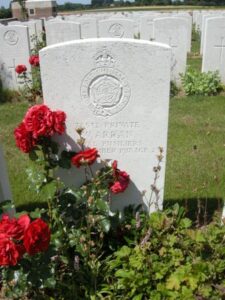
William Arran, Sapper, Royal Engineers. William was the father of William Arran, above. He had served with the Army Service Corps for three years but was invalided home after having had his foot badly injured by a shell at Ypres. He appears to have been posted to Ireland, probably with the Royal Engineers. Nothing more is currently known of him, as he is not commemorated by the CWGC.
Ernest Axford, Trimmer, 302TS, Royal Naval Reserve. Ernest was born on 16 July 1896 at Milford Haven, and was the Adopted son of Simon and Elizabeth Davies, of 15, Perrotts Terrace, Barn Street, Haverfordwest. He served with the Royal Naval Reserve, aboard H.M. Trawler Kirkland. She was requisitioned during August 1914, for service as a mine sweeper. Ernest was drowned when the Kirkland struck a mine off Fugla Skerry, Papastour, Shetlands, on 20 August 1917. He was 21 years old, and is commemorated on the Plymouth Naval Memorial, Devon. Many thanks to Shirley Thomas for the photograph.
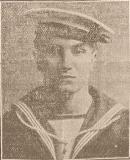
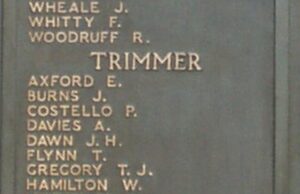
James Allen Bevan, Driver, T4/254138, Army Service Corps. James was the son of James and M. Bevan, of 1, Ebenezer Row, Haverfordwest. He served with the Army Service Corps, and was posted to Salonika, where he served as a Driver with the 857th Horse Transport Company. James died at Salonika on 24 November 1918 aged 23, and is buried in Mikra British Cemetery, Kalamaria. Many thanks to Adrian Wright for the photograph of the headstone.
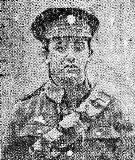
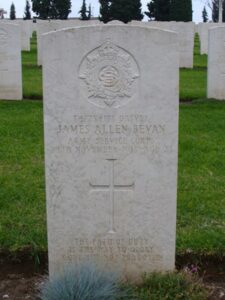
James Ernest Codd, Sergeant, 2297, Welsh Regiment. James was born at Haverfordwest in 1871, the son of William Evans Codd and Martha Codd. He married Mary Ann Lewis at Haverfordwest on 12 August 1896, and the couple resided at 9, North Gate Terrace, Haverfordwest, where James worked as a Yeast Merchant. Between 12 March 1899 until 31 March 1908, James also served with the 1st Volunteer Battalion, Welsh Regiment, and on 13 April 1908 enlisted at Haverfordwest into the newly formed 4th Battalion, Welsh Regiment, the local Territorial unit. James attended the annual camp several times over the coming years, and at the outbreak of the Great War was embodied for service with ‘A’ Company, 4th Welsh at Haverfordwest. James was by now a Sergeant, and remained on Home Service with the 2/4th Welsh, assisting withy the training of new recruits for the front line 1/4th Welsh. James was discharged from the army as medically unfit on 30 September 1916 after becoming ill with bronchial asthma and a hernia. He died early in 1917 at Haverfordwest, aged 45, and is possibly buried in St. Martins Churchyard, Haverfordwest. Despite numerous efforts by myself, he is ineligible for commemoration by the CWGC as his illness has been deemed as not linked to his military service.
Harold Edmund Collins, Sapper, 15477, Royal Engineers. Harold was born on 7 August 1886, the son of James Collins and Mary Ann Collins (nee Roberts), of Northgate, Haverfordwest. He worked for the Great Western Railway prior to the war. Harold had married Bessie Powis at Ledbury in 1908 and the couple had lived at Barry, before moving to 5, Cumberland Road, Newport, Mon. Harold enlisted at Swansea into the Royal Engineers, and was posted to the 5th Field Company. The Company was sent to the Western Front with the BEF at the outbreak of war, disembarking on 15 August 1914, and moved with the BEF to the Belgian frontier. The Company then took part in the fighting at Mons on 23 August, and in the epic retreat south to the Marne. The Germans were stopped at the Marne, and withdrew North to the Aisne, so the BEF advanced north to the Aisne, where they met in battle. Harold was wounded here, during the Battle of the Aisne, and died of wounds on 9 October 1914. He was 30 years old, and is buried at Soupir Churchyard, France. After Harolds death, Bessie moved to Welcheston Lodge, Woolhope, Hereford with their four sons, and a fifth was born there just six months after Harold’s death. His headstone carried the sad epitaph: ‘SADLY MISSED BY WIFE & 5 SMALL SONS. REST IN THE LORD’
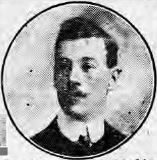
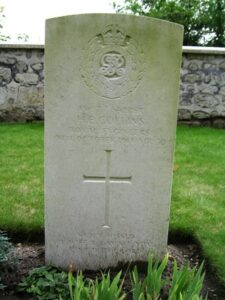
Austin Pugh Cook, Lieutenant, Royal Marine Light Infantry. Austin was born in 1893, the son of Charles Pugh Cook and Mary Ann Cook (nee Phillips), of 21, Bridge Street, Haverfordwest. He entered St. David’s College from Haverfordwest Grammar School in October 1912, and graduated B.A. before being commissioned into the Royal Marine Light Infantry in 1915. Austin served with the 2nd Royal Marine Battalion, Royal Naval Division. The Naval Brigades were originally sent to Antwerp and Dunkirk in September and October 1914 to guard against invasion by the Germans. However, Antwerp fell to the Germans soon after, and so many of the RND units were withdrawn to England. After a lengthy period of refit and training the Division moved to Egypt preparatory to the Gallipoli campaign. Landing on 25 April 1915 the Division fought throughout the Campaign on Gallipoli. They were transferred from the authority of the Admiralty to the War Office on 29 April 1916 and was redesignated the 63rd (Royal Naval) Division on 19 July 1916. The Division moved to France, arriving at Marseilles between 12 and 23 May 1916 and moved to positions on the Somme, where it took part in the Battle of the Ancre, and the resulting Operations on the Ancre. In April 1917 the Division was at Arras, and fought at the Second Battle of the Scarpe, where they captured Gavrelle. They then fought at the Battle of Arleux. Austin was killed in action near Gavrelle on 26 July 1917. He was 23 years old, and is buried at Naval Trench Cemetery, Gavrelle, France.
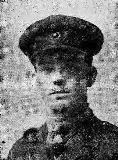
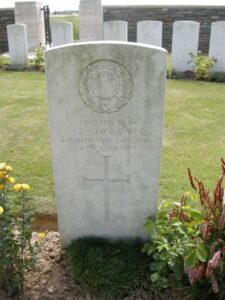
Francis Newton Allen Cromie, CB, DSO, Captain, Royal Navy. Francis was born in Duncannon Fort, Wexford, Ireland on 30 January 1882, the son of Captain Charles Francis Cromie, Hampshire Regiment, and of Mary Grace Josephine Cromie (nee Webb-Bowen), daughter of Thomas Ince Webb-Bowen, of Haverfordwest. Following the divorce of his parents in 1891, Francis and his mother returned to Pembrokeshire, settling initially at High Street, Fishguard, and Francis was educated at Fishguard National School, before winning a scholarship to Haverfordwest Grammar School. He left school in 1897 to join the Royal Navy and after passing out from HMS Britannia joined the crew of HMS Repulse, before becoming a midshipman aboard HMS Barfleur, taking part in the Seymour Expedition to China, for which he received the China War Medal with Peking clasp. Over the coming years he was promoted to Acting Sub-Lieutenant, then Lieutenant and in 1903 volunteered to join the Royal Navy Submarine Service, becoming one of the first officers to command a submarine. In 1906 he was awarded the bronze Royal Humane Society medal, after attempting to save one of his sailors who was swept overboard. He married a cousin, Gladys Catherine Josephine Cromie, in 1906, whilst on leave from the Royal Navy. Over the coming years he commanded the depot ship HMS Onyx and a flotilla of submarines at Devonport, before assuming command of the Hong Kong submarine flotilla. In August 1915 he commissioned the submarine HMS E19, forcing a passage into the Baltic to support the Russian Baltic Fleet, where he had great success, leading to his promotion to Commander. On 31 May 1916 he received the Distinguished Service Order (DSO), followed by a succession of imperial Russian orders; Order of St. Anna (2nd Class with Swords), Order of St. Vladimir (4th Class with Swords), Order of St. George (4th Class), as well as the French National Order of the Legion of Honour (Chevalier). He was then promoted Captain and appointed as naval attaché to the British Embassy in Petrograd (later Saint Petersburg), Russia, where he played a vital role following the outbreak of the Russian Revolution. He was attacked and killed in the Embassy by Bolsheviks on 31 August 1918. The36-year-old has no known grave and is commemorated on the Archangel Memorial in St. Petersburg. He was posthumously awarded the Companion of the Order of the Bath ‘In recognition of his distinguished service in the Allied cause in Russia, and of the devotion to duty which he displayed in remaining at his post as British Naval Attaché in Russia, when the British Embassy was withdrawn. This devotion to duty cost him his life.’

Henry Davies, Private, 26934, Welsh Regiment. Henry was born at St. Martins, Haverfordwest, and enlisted there into the 1st Battalion, Welsh Regiment. The Battalion was in India at the outbreak of war, and was recalled to Britain, where it joined 84 Brigade, 28th Division. The Division formed in England between December 1914 and January 1915 from regular units returning from India, Singapore and Egypt. During January 1915 it moved to France, landing at Le Havre and moved to the Western Front, where it saw its first major action during the Second Battle of Ypres. Following serious casualties at Ypres, a Composite Brigade was formed, composing of the 2nd Battalion, the Buffs, 2nd Battalion, the Cheshires, 1st Battalion, the Welsh, and 1st Battalion, the York and Lancaster. It was dissolved on the 19th May 1915, and the formation assumed its normal configuration, taking part in the Battle of Loos. Henry was killed in action just before the Division was pulled from the line to embark for Salonika, on 2 October 1915. He has no known grave, and so is commemorated on the Loos Memorial, France.
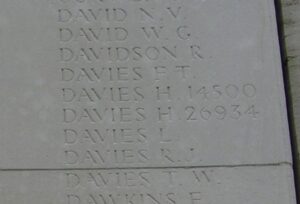
William Davies, Private, 220, Welsh Regiment. William was born at Haverfordwest and enlisted there into the 1/4th Battalion, Welsh Regiment. The Battalion had been formed at Carmarthen during August 1914 and became attached to 159 Brigade, 53rd (Welsh) Division. The Division moved to the Mediterranean, sailing from Devonport in July, 1915 arriving at Mudros by 5 August 1915. From here they moved to Gallipoli, landing on 9 August. Here they immediately faced the chaotic leadership that was to lead to the ultimate failure of the campaign, and spent the next few days in isolated pockets, fighting against a Turkish counter-attack during the Battle of Sari Bair, and then at the Attack on Scimitar Hill. William was wounded during the first few weeks at Gallipoli and evacuated for treatment at Mudros Island. He died there on 28 September 1915 and is buried in East Mudros Military Cemetery, Gallipoli.
Cyril Norman Green, Driver, 122243, Royal Field Artillery. Cyril was born at Pembroke Dock, the son of John and Bessie Rundle Green, later of 7, Bridge Street, Haverfordwest. Cyril had moved around West Wales, living at Tenby, Brecon, and Haverfordwest, which is where he enlisted into the Royal Field Artillery, serving with the 55th Division Ammunition Column, attached to the 55th (West Lancashire) Division. The complete Division was reformed in France between 3 and 27 January 1916 in the Hallencourt area, and relieved the French 88th Division south of Arras, in the area Wailly- Bretencourt by 16 February. Trench warfare commenced, with many raids and minor operations. Relieved by the 11th (Northern) Division on 25 July, the 55th now moved south and took up a place in the front line opposite the village of Guillemont. Here they fought at the Battle of Guillemont and the Battle of Ginchy. There was a short period of rest at Ribemont from 12 to 17 September, and then the Division fought at the Battle of Flers-Courcelette and the Battle of Morval. Relieved by 41st Division on 28 September, the Division withdrew to the area of Buire and Ribemont, before relieving the 29th Division in the Ypres salient in October 1916. It was destined to remain in this area for almost a year, stationed near Railway Wood. Cyril was wounded at Railway Wood, and evacuated to the Base Hospital at Boulogne, where he died of wounds on 11 March 1917. He was just 21 years old, and is buried in Boulogne Eastern Cemetery, France.
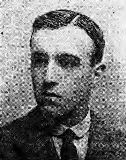
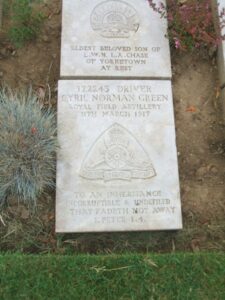
Archie Griffiths, Private, G/5868, Royal Sussex Regiment. Archie was the son of William and Maria Griffiths, of 44, Dew Street, Haverfordwest. He enlisted in September, 1914 into the 2nd Battalion, Royal Sussex Regiment, which was attached to 2 Brigade, 1st Division. The Division had been one of the first to arrive in France, fighting at the Battle of Mons, and taking part in the retreat to the Marne, where the Germans were stopped. They then fought at the Aisne, and at Chivy, before being moved North to Ypres. Here they fought at the First Battle of Ypres, where they again stopped the German Offensive, before wintering in Flanders. The following year saw them in action again at the Battle of Aubers, before moving South to Loos, where they fought during the Battle of Loos, and the action at the Hohenzollern Redoubt. Archie was killed in action whilst the Division was near Arras, on 30 June, 1916, just prior to their move to the Somme. He was just 20 years old, and is commemorated on the Arras Memorial, France. His brother Walter James Griffiths also fell.
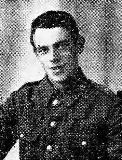
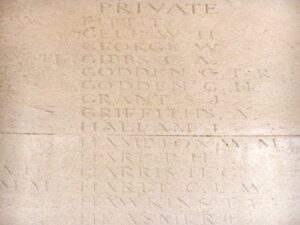
Frederick Griffiths, Private, 111677, Tank Corps. Frederick was born at St. David’s in 1892, the son of Thomas and Elizabeth Griffiths. By 1901 the family was residing at 6, North Gate, Haverfordwest. Frederick and enlisted at Haverfordwest into the Royal Field Artillery, with the Regimental Number 263376. He was transferred into the Tank Corp sometime after 1916, and served with the 11th Battalion, Tank Corps. Frederick was killed in action during the period of the offensive against the mighty Hindenburg Line, on 27 September 1918, aged 26. He is buried in Gouzeaucourt New British Cemetery, France. His brother Ivor also fell.
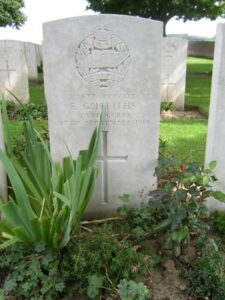
Ivor Griffiths, Private, 445, Welsh Regiment. Ivor was born at St. Davids, the son of Thomas and Elizabeth Griffiths. The family later resided at 6, North Gate, Haverfordwest. Ivor enlisted at Haverfordwest into the 1/4th Battalion, Welsh Regiment. The Battalion was formed at Carmarthen during August 1914 and was attached to 159 Brigade, 53rd (Welsh) Division. The 53rd Division moved to the Mediterranean, sailing from Devonport in July 1915 arriving at Mudros by 5 August 1915. From here they moved to Gallipoli, landing on 8 August. Here they immediately faced the chaotic leadership that was to lead to the ultimate failure of the campaign, and spent the next few days in isolated pockets, and fought at the Battle of Sari Bair, where Ivor was wounded. He was evacuated from Gallipoli, and brought to Gibraltar for treatment, but sadly died at sea of his wounds on 4 September 1915, aged 19. Ivor was buried ashore, at Gibraltar (North Front) Cemetery. His brother Frederick also fell.
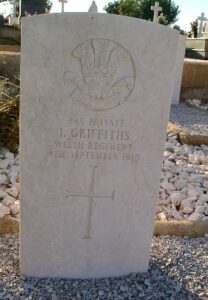
Francis Alexander Blair Harper, Deck Hand, 3925DA, Royal Naval Reserve. Francis was born was born in Aberdeen on 16 August 1884 and was a fisherman. After the outbreak of war he served with the Royal Naval Reserve, aboard HM Trawler, Ocean Angler. Francis’ wife Isabella died on 18 January 1917 leaving him with three daughters to look after, so Francis moved his three daughters, Mary, Frances and Mabel, to Haverfordwest, close to his base at Milford Haven. Soon after this he married Alice Warlow in Haverfordwest, and the couple had a son, Frank Harper. Sadly not long afterwards, Francis died in hospital in Ireland, on 8 February 1919, aged 34. He was brought home for burial at St. Martin’s Cemetery, Haverfordwest. Many thanks to Mr. Alex Buchan for sending in additional information about Francis.
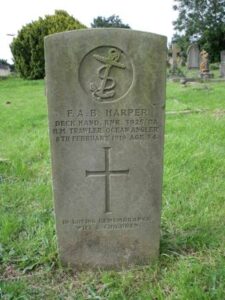
Seth John Harries, Private, 320015, Welsh Regiment. Seth was born at Haverfordwest in 1889, the son of John and Phoebe Harries. He enlisted there into the Pembroke Yeomanry, with the Regimental Number 251. The Pembroke Yeomanry was attached to the South Wales Mounted Brigade, and moved to Egypt in 1916 where it was dismounted, and used for duties on the Suez Canal defences. In early 1917 the Battalion was merged with the Glamorgan Yeomanry to form the 24th (Pembroke & Glamorgan Yeomanry) Battalion, Welsh Regiment, attached to 231 Brigade, 74th (Yeomanry) Division. The Division had formed in Egypt in January, 1917 and had fought through the Palestinian Campaign, at the Battles of Gaza and the Battle and capture of Jerusalem. Seth was killed during the Third Battle of Gaza, on 6 November 1917, aged 29. He is buried in Beersheba War Cemetery, Israel.
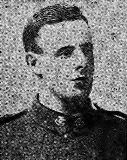
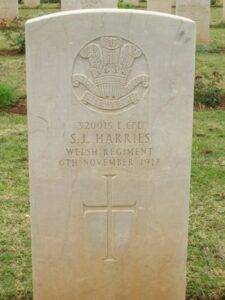
Sidney James, Private, 76210DA, Royal Welsh Fusiliers. Sidney was the son of James and Elizabeth James, of 46, City Road, Haverfordwest. Sidney served with a Home Service Battalion of the Royal Welsh Fusiliers, and died at Herne Bay Military Hospital on 18 December 1918, aged just 19. He is buried in St. Martin Cemetery, Haverfordwest.
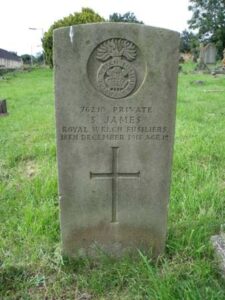
Charles Jenkins, Second Lieutenant, Royal Flying Corps. Charles was born on 2 January 1897, the second son of John Lewis Jenkins and Bessie Jenkins (nee Mitchell), of Cleddau Lodge, Haverfordwest. Educated at Haverfordwest Grammar School, Charles then attended the London Wireless College, and from there he enlisted into the Signal Section of the Royal Engineers on 11 November 1914. Charles then served on the Western Front from January 1916 and returned to England in July 1917 to train at Winchester and Oxford. In November 1917 Charles was gazetted 2nd Lieutenant in the Royal Flying Corps and gained his Wings in January 1918. Charles was sadly killed whilst training aboard a Sopwith Camel, B7370, from the Central Flying School at Upavon, Wiltshire, when the aircraft failed to pull out of a dive and crashed on 21 March 1918. The remains of the 21-year-old were recovered from the wreckage, and he was conveyed back to Pembrokeshire for burial in St. Mary’s Church Cemetery, Haverfordwest. His Commanding Officer wrote in a letter to John and Bessie; ‘Your son was a fine and fearless Pilot, very popular, and we feel his loss keenly’. His brother, Harold Rhys Jenkins, served during WW2 with the Merchant Navy. He survived the sinking of his ship in 1942 but spent the rest of the war in captivity and died in 1948.
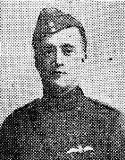
Clement Daniel Jones, Private, G/29321, Middlesex Regiment. Clement was born at Haverfordwest in 1887, the son of George and Mary Jones. He worked as a Draper prior to the war, for Messrs J. Barnes Co. Ltd, 191 and 217 Finchley Rd, Hampstead, and enlisted there into the 21st Battalion, Middlesex Regiment. The Battalion was raised in Islington by the Mayor and Borough on 18 May 1915, and in July 1915 joined 118 Brigade, 39th Division. Taken over by the War Office in August, they moved in October 1915 to Aldershot, then in February 1916 to Witley, where the Battalion moved to 121 Brigade, 40th (Bantam) Division. During June 1916 the Division landed in France, and moved to the front near Loos. Late in 1916 they moved south to the Somme, and fought at the Battle of the Ancre, and remained in the area over the winter. In March 1917 the Germans withdrew to their shortened line, called the Hindenburg Line, and the 40th Division was one of the Divisions that followed the withdrawal. Later in the year they took part in the Battle of Cambrai, playing an important role in the attack on Bourlon Wood. Clement was wounded at Cambrai, and died of wounds on 24 November 1917. He was buried on the battlefield, but his grave must have been lost over the coming few months of fighting in the area, as he is commemorated on the Cambrai Memorial, Louverval, France. His brothers, Peter McKenzie Jones and John Daniel Jones, also fell.
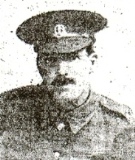
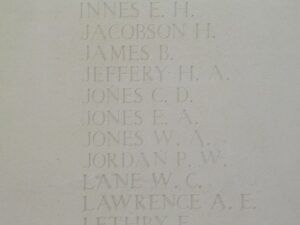
John Daniel Jones, Lieutenant, Royal Field Artillery. John was born in 1871, the son of George and Mary Jones, of Haverfordwest. His wife, Mrs A. M. Jones, resided at 53, Charlton Road, Blackheath, Kent. John was a long serving soldier, and had completed 28 years service by the time war erupted, and landed in France on 19 August 1914 as a Battery Sergeant Major with the 28th Brigade, Royal Field Artillery. John would have taken part in the epic retreat from Mons to the Marne, and on 3 November 1914 was commissioned as a Lieutenant. He served on the Western Front throughout several major battles thereafter, taking part in First and Second Ypres. John was wounded at the beginning of 1916, and evacuated to the Base Hospital at Le Havre, where he sadly died of his wounds on 21 February 1916, aged 45. John is buried there, at Ste. Marie Cemetery, Le Havre, France. His brothers, Peter McKenzie Jones and Clement Daniel Jones, also fell.
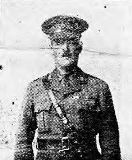
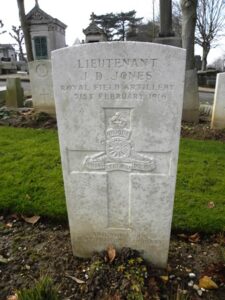
Peter McKenzie Jones, Private, 122194, Machine Gun Corps. Peter was the son of George and Mary Jones. He was a native of Haverfordwest, but the family had moved to London prior to the war, living at Paddington. Peter enlisted at Woolwich into the Army Ordnance Corps, with the Regimental Number 029162, but was later transferred into the 35th Battalion, Machine Gun Corps, which was attached to the 35th Division. The Division had moved to France in late January and early February 1916. It saw its first major action during the Battle of the Somme, at the Battle of Albert. After a spell out of the line, rebuilding, the Division followed the German Retreat to the Hindenburg Line in March 1917. Later in the year they moved north to Ypres, and fought at the Second Battle of Passchendaele. By Spring of 1918 they were back on the Somme, and fought at the First Battle of Bapaume, during the German Offensive. They were then moved back north, and fought later in the year at the Battle of Ypres, and then the Battle of Courtrai, and the subsequent Action of Tieghem. Peter was wounded during Fourth Ypres, and sadly died of his wounds at the Casualty Clearing Station west of Ypres, known as Remy Sidings, on 16 October 1918. He was 30 years old, and is buried there, at Lijssenthoek Military Cemetery, Belgium. Peter is shown as Welsh Regiment on the Memorial. His brothers John Daniel Jones and Clement Daniel Jones also fell.
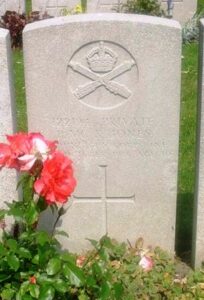
David Rees Lewis, Private, 53981, Welsh Regiment. David was the son of John Lewis, of 60, City Road, Haverfordwest. He married Sarah Alice Owens in 1912, of 137, Back Lane, Prendergast, Haverfordwest. David enlisted at Haverfordwest into the Welsh Regiment, and was posted to the 15th Battalion, Welsh Regiment, which was the Carmarthen Pals battalion, attached to 114 Brigade, 38th (Welsh) Division. The Division had landed in France during December 1915 and had spent their first winter in the trenches near Armentieres. In June they marched south to the Somme, where they took part in the famous capture of Mametz Wood. David probably joined the battalion after it had moved to Boesinghe, north of Ypres, in August 1916. Here they fought at the Battle of Pilckem Ridge, and the Battle of Langemarck. They then moved to Armentieres, where they remained from September 1917 until March 1918 when the German Spring Offensive was launched. The British had been over-run on the Somme, and so in April the Division was moved South, taking up positions North of Albert, from where they weathered the storm of the coming months. On 10 May 1918 the 15th Welsh were ordered to assault the German lines inside Aveluy Wood, and were to be supported by a creeping artillery barrage. Sadly due to an error in range calculations, the shellfire fell short, and created havoc amongst the 15th Welsh. David was one of many men killed that day. He was 24 years old and is buried in Martinsart British Cemetery, France.
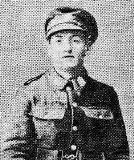
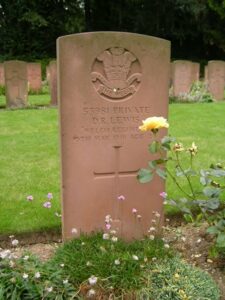
Thomas Henry Lewis, Private, 27474, Kings Shropshire Light Infantry. Thomas was the Husband of Martha Jane Lewis, of 1, Queen’s Square, Haverfordwest. He enlisted there into the Welsh regiment, with the Regimental Number 3657, but later transferred into the 1st Battalion, Kings Shropshire Light Infantry, which was attached to 16 Brigade, 6th Division. On 10 September 1914 the Division landed at St Nazaire and proceeded to the Western Front, and arrived in time to reinforce the hard-pressed BEF on the Aisne, before the whole army was moved north into Flanders. Here they took part in the Action of Hooge during June 1915, and in 1916 moved to the Somme, where the Division fought at the Battle of Flers-Courcelette, the Battle of Morval and the Battle of Le Transloy. The following year saw them at Arras, where they fought at the Battle of Hill 70, and then during the Battle of Cambrai later in the year. In the spring of 1918 the Division was one of those hit by the German Offensive on the Somme, which had been launched on 21 March, and the Division took part in the Battle of St Quentin. They were moved from the line, and went to Flanders to rest, but the following month the Germans launched another offensive on the Lys, and the Division fought during the resulting withdrawal. During August 1918 the Allies had recovered sufficiently to be able to launch their own attacks on the Germans, and after a brilliant victory at Villers Brettoneux on 8 August, attacks were launched at Albert. The 6th Division took part in the Advance in Flanders, before moving south, where they took part in the advance on the Hindenburg Line, during the Battle of Épehy. Thomas was killed in action here on 24 September 1918. He was 35 years old, and is buried in Trefcon British Cemetery, Caulaincourt, France.
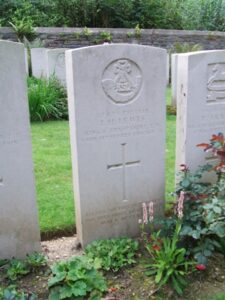
James William Manning, Private, 277854, Royal Engineers. James was the son of John and Elizabeth Manning, of Webbs Hills, Walton West. He married Dorothy Ellen Collins at Haverfordwest in 1909, and the couple resided at 28, North Crescent, Haverfordwest. James had worked as a monumental mason at Haverfordwest prior to the war and after failing a military tribunal, enlisted on 8 May 1917 into the Royal Engineers. James was posted to the 488th Field Company, Royal Engineers in February 1918, but was discharged due to ill health on 28 October 1918. James died at Haverfordwest on 13 March 1919 aged 33. It is not presently known where James is buried, but his details were passed to the CWGC on 6 February 2013, as a result of my research, and he has been accepted for commemoration on Friday 15 August 2014. His name will be added to the United Kingdom Book of Remembrance until the location of his grave can be found.
William Howard Martin, Second Lieutenant, Royal Welsh Fusiliers. William was born in 1887, the son of Thomas Henry Martin and Martha Martin (nee Harries), of 14, Kensington Terrace, Barn Street, Haverfordwest. After completing his education at Haverfordwest Grammar School, William enlisted into the Artists Rifles, before being commissioned Second Lieutenant into the 3rd Battalion, Royal Welsh Fusiliers on 8 September 1916. Upon being drafted to France on 19 October 1916, William was posted to the 2nd Battalion, Royal Welsh Fusiliers. The Battalion had been on the Western Front since the outbreak of war, and by early 1916 was attached to 19 Brigade, 33rd Division. The Division moved to positions on the Southern end of the Somme sector, and fought through the Battles of the Somme, from July 1916 onwards. The Division then saw terrible fighting at Arras the following Spring, taking part in the Battle of the Scarpe and then at Bullecourt, before heading to the Flanders Coast near De Panne, in preparation for a possible assault along the coast. William by then had become attached to D Company of the 13th Battalion, Royal Welsh Fusiliers which was attached to the 38th (Welsh) Division. He was killed in action at Ypres on 31 July 1917, during the opening assault on the Pilckem Ridge The 29-year-old has no known grave and is commemorated on the Ypres (Menin Gate) Memorial, Belgium.
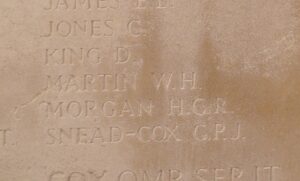
Thomas Morgan Mathias, Company Sergeant Major, 2, Welsh Regiment. Morgan was the husband of Edith Alice Mathias, of 14, North Crescent, Haverfordwest. He had served in the South African Campaign, and was recalled to the colours at the outbreak of war, becoming a Company Sergeant Major in the 1/4th Battalion, Welsh Regiment, at Carmarthen. Morgan was issued the Regimental Number 2. The Battalion became attached to 159 Brigade, 53rd (Welsh) Division some months later, and moved to the Mediterranean, sailing from Devonport in July 1915, and arrived at Mudros by 5 August 1915. From here they moved to Gallipoli, landing on 9 August. Here they immediately faced the chaotic leadership that was to lead to the ultimate failure of the campaign, and spent the next few days in isolated pockets, fighting against a Turkish counter-attack during the Battle of Sari Bair, and then at the Attack on Scimitar Hill. Morgan was killed in action on his second day at Gallipoli, on 10 August 1915. He was 39 years old, and having no known grave, is commemorated on the Helles Memorial, Gallipoli.
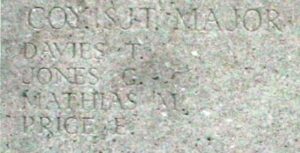
Edwin Morgan, Able Seaman, 184874, Royal Navy. Edwin was born on 29 August 1877, the son of Henry and Ann Morgan, of 78, City Road, Haverfordwest. On his 18th birthday, on 29 August 1895, he enlisted into the Royal Navy for 12 years, and was posted to HMS Northampton. Over the following years he served aboard a multitude of ships, including HMS Revenge, Britannia, Majestic, Caesar and Minotaur, before completing his service on 29 August 1907. Edwin must have enjoyed life at sea, as he remained in the Royal Navy, and by the outbreak of war was back serving aboard HMS Britannia. He served at sea for a further two years during the war, but was discharged on 13 June 1916 after becoming ill, and was diagnosed with Pulmonary Tuberculosis. He died at Haverfordwest on 5 June 1917, aged 39, and was buried in St. Martin’s Cemetery, Haverfordwest. Edwin’s case was passed to the CWGC in August 2014, as a result of my research, and he has been accepted for commemoration on Saturday 31 January 2015. His name will be added to the United Kingdom Book of Remembrance until the location of his grave has been verified by the CWGC.
James Henry Morgan, Driver, 38442, Royal Engineers. James was born in Pembroke, the son of James and Martha Morgan, later of 3, North Gate, Haverfordwest. He enlisted at Haverfordwest into the Royal Welsh Fusiliers, but was later transferred to the Royal Engineers. He was posted to their 127th Field Company, attached to the 22nd Division. The Division crossed to France in early September 1915, with all units being concentrated near Flesselles by the 9th of the month. However it’s stay in France was to be very short, as on 27 October, 1915 the Division, having been moved by train to Marseilles, began to embark for Salonika. It completed concentration there in November, although the final artillery units were still coming in as late as the 13th December 1915. It remained in the theatre for the rest of the war, taking part in the Retreat from Serbia during December, 1915. From 10 August until 18 August 1916 the British took part in the battle of Horseshoe Hill, and around this time, James took ill and was hospitalised. He died on 22 August 1916, aged 21, and is buried in Salonika (Lembet Road) Military Cemetery, Greece.
James Oliver, Private, 200189, Welsh Regiment. James was born on 1 March 1889, the son of John and Margaret Oliver, of 18, Spring Gardens, Haverfordwest. James was educated at Haverfordwest, and worked there as a Compositor prior to the war. When war was declared in August 1914 James enlisted at Haverfordwest into the 1/4th Battalion, Welsh Regiment, which was attached to 159 Brigade, 53rd (Welsh) Division. Just after enlisting, James married Frances Charlotte Hale Davies, daughter of Richard Davies, of 26, Prendergast Hill, Haverfordwest. The Division then moved to the Mediterranean, sailing from Devonport in July 1915 and arriving at Mudros by 5 August 1915. From here they moved to Gallipoli, landing on 9 August. Here they immediately faced the chaotic leadership that was to lead to the ultimate failure of the campaign, and spent the next few days in isolated pockets, fighting against a Turkish counter-attack. The Division remained here throughout the coming months, and suffered severe losses in manpower strength during the great November 1915 blizzard on Gallipoli, when its total strength was reduced to less than that of a full-strength Brigade. On 11 December 1915 the Division was evacuated to Mudros, and by the 23rd December 1915 were moved to Egypt. They remained on the Suez Canal Defences for the next twelve months, and in early 1917 moved into Palestine, where they remained for the duration of the war, fighting at the Battles of Gaza, and successfully capturing Jerusalem. James was wounded during Operations in the Jordan Valley, and died on 10 March 1918. He was 28 years old, and is buried in Jerusalem War Cemetery, Israel.
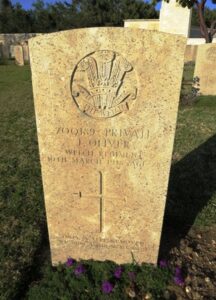
Francis Leonard Owen, Private, 10021, Royal Fusiliers. Francis was born in 1894, the son of William Henry Owen and Eliza Owen (nee Johns), of 3, Gloucester Terrace, Haverfordwest. After completing his education at Haverfordwest Grammar School, Francis worked as a grocer’s assistant with Rees Brothers, at Haverfordwest. He enlisted at Haverfordwest into the army in November 1916 and upon being drafted to France was posted to the 12th Battalion, Royal Fusiliers, which was attached to 17 Brigade, 24th Division. The Division had moved to France during August 1915 and had seen its first major action soon afterwards during the Battle of Loos, being sent into action on 26 September 1915, but suffered terrible casualties due to not being properly trained, so was withdrawn from the line until the following year. Francis joined the battalion on the Somme, after it had seen heavy fighting at Delville Wood and Guillemont, before the entire Division moved to positions near Mazingarbe, north of Arras, in early 1917. At dawn on 26 January 1917 the 12th Royal Fusiliers carried out a daylight trench raid against the German lines facing their positions at the Village Lines, successfully killing dozens of Germans, capturing 16 prisoners, and bombed several dugouts. Francis was killed in action during the raid that day, on 26 January 1917. The 22-year-old is buried in Philosophe British Cemetery, Mazingarbe. His nephew, Leonard George Phillips Owen, was killed in WW2, whilst serving with the Parachute Regiment.
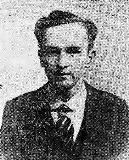
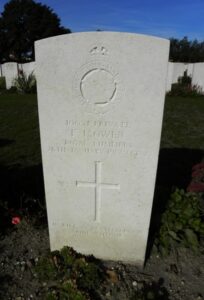
Charles Picton Owens, Engineman, 4846ES, Royal Naval Reserve. Charles was born on 1 March 1890, the son of Thomas and Anne Owens, of 40 Prendergast, Haverfordwest. He was an engineer at Milford Haven prior to the war, and resided with his wife Lilian Owens, at 12 City Road, Haverfordwest. Charles served in the Royal Naval Reserve, aboard H.M. Drifter Active III. Charles died when she was lost at sea on 15 October 1917. He was 27 years old, and is commemorated on the Plymouth Naval Memorial, Devon.
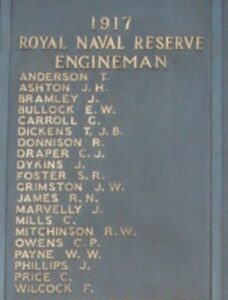
William John Peterson, Lance Corporal, 50289, Machine Gun Corps. William was originally born as William John Jones, and was the son of Florence Mary Jones. She later married Mr G. Peterson, of 63, Merlins Hill, Haverfordwest and William took his step-fathers surname. William had served during the Great War as a Machine Gunner, but was possibly wounded towards the end of the war, as he died in hospital at Cardiff on 19 February 1919, aged 22. William is buried in St. Martin’s Cemetery, Haverfordwest.
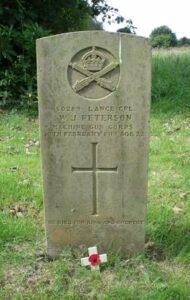
William Phillips, Private, 45761, Welsh Regiment. William was born at Llawhaden in 1881, the son of William and Hannah Phillips. By 1911 the family had moved to 26, City Road, Haverfordwest. William enlisted at Haverfordwest into the army, and was posted to the 16th (Cardiff) Battalion, Welsh Regiment, which was attached to 115 Brigade, 38th (Welsh) Division. The Division had landed in France during December 1915 and had spent their first winter in the trenches near Armentieres. In June they marched south to the Somme, where they famously captured Mametz Wood. The Division suffered terrible casualties at Mametz, and were taken out of the line, and moved to Ypres to rebuild. Here they fought at the Battle of Pilckem Ridge, and the Battle of Langemarck. William was killed in action here on 4 August 1917, aged 36. He has no known grave, and is commemorated on the Ypres (Menin Gate) Memorial, Belgium.
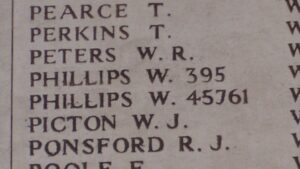
William Thomas Phillips, Private, 54384, Welsh Regiment. William was born in Haverfordwest, and enlisted there into the Welsh Regiment. He served with the 16th Battalion, which was attached to 115 Brigade, 38th (Welsh) Division. The Division had landed in France during December 1915 and had spent their first winter in the trenches near Armentieres. In June they marched south to the Somme, where they took part in the successful capture of Mametz Wood. The Division suffered terrible casualties at Mametz, and were taken out of the line, and moved to Ypres to rebuild. Here they fought at the Battle of Pilckem Ridge, and the Battle of Langemarck. William was killed in action here on 27 August 1917, when the 16th Welsh made a gallant assault on positions near Langemarck Village, under terrible conditions. He has no known grave, and is commemorated on the Tyne Cot Memorial, Belgium.
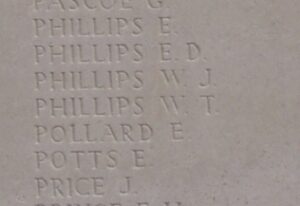
Daniel Hugh Reynish, Private, 5217, London Regiment. Daniel was the son of James and Elizabeth J. Reynish, of 60, Barn Street, Haverfordwest. He lived at Battersea prior to the war, and enlisted there into the 23rd Battalion, London Regiment. The Battalion formed at St. John’s Hill, London during August 1914 and became attached to 142 Brigade, 47th (2nd London) Division. The Division moved to France in March 1915. The Division fought at the Battle of Aubers, and the Battle of Festubert during May 1915 and in September fought at the Battle of Loos, and subsequent Action of Hohenzollern Redoubt. They were north of Arras when the Germans attacked Vimy Ridge, and then moved south to the Somme, where they fought at the Battle of Flers-Courcelette, and then at the Battle of Le Transloy, where the Division captured Eaucourt l’Abbe, and took part in Attacks on the Butte de Warlencourt. They then moved north to Flanders, and it was there that Daniel was wounded soon after arriving there. He was taken to the Casualty Clearing Station at Remy Sidings for treatment, but died of his wounds there on 27 November 1916. Daniel was 35 years old, and is buried in Lijssenthoek Military Cemetery, Belgium.
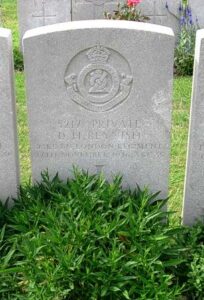
James Gwynne Vaughan Rowlands, Rifleman, 393080, London Regiment. James was the son of William Gwynne Rowlands and Mary Rowlands (nee Vaughan), of 1, Castle Terrace, Haverfordwest. Upon completing his education at Haverfordwest Grammar School he found work in London, then upon the outbreak of war enlisting at London into the 28th Battalion (Artists Rifles), London Regiment. He was subsequently posted to the 2/9th (County of London) Battalion (Queen Victoria’s Rifles), London Regiment, which was at Ipswich attached to 175 Brigade, 58th (2/1st London) Division. The division began embarking for France on 20 January 1917 and had concentrated by 8 February, with the 2/9th Battalion landing at Le Havre on 4 February 1917. The Division then followed the German Retreat to the Hindenburg Line, before taking part in the Battle of Arras, seeing heavy fighting during the 2nd Battle of Bullecourt in May 1917, alongside the Australians. The division then saw further fighting on the Hindenburg Line before being transferred to the Ypres Salient, taking part in the Battle of the Menin Road Ridge from 20–25 September. After a brief rest the division was thrown into action again during the Battle of Polygon Wood on 26 September, attacking from positions on the Canal Bank. James was killed in action on the following day, 27 September 1917, following a German counterattack. The 22-year-old has no known grave, so is commemorated on the Tyne Cot Memorial, Belgium.
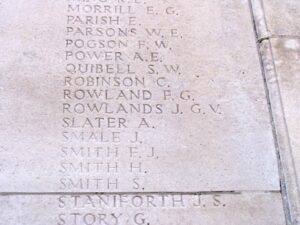
George Thomas Sydney Rumball, MC, Lieutenant, Royal Fusiliers. George, known as Sydney, was born in Colchester on 18 February 1896, the son of George Rumball and Clara Rumball (nee Blake). Sydney was educated at Haverfordwest Grammar School, then worked as a clerk for the General Post Office’s telephone engineering and manufacturing facility at the Mount Pleasant factory. He joined the Civil Service Army Cadets in March, but left in July due to a lack of time, and re-enlisted in March 1915, as a Private in the RAMC, serving in France from August 1915 based at the 33rd Casualty Clearing Station. In August 1916 George applied for a regular army commission and was gazetted as a temporary 2nd Lieutenant on 2 April 1917, being posted to the 2nd Battalion Royal Fusiliers, who were at Arras, attached to 86 Brigade, 29th Division. The Division had suffered heavy casualties during the Battle of Arras over the preceding weeks, and George was probably a reinforcement. In August 1917 the 29th Division relieved the 38th Welsh Division at Boesinghe, and George was awarded the Military Cross here, “for conspicuous gallantry and devotion to duty. He led patrols on four consecutive nights, returning on each occasion with valuable and accurate information. The consistent example of courage and determination which he set inspired all his men to exert themselves to the utmost. Boesinghe sector (Belgium) 7 to 10 August 1917”. Over the coming months George took part in the Battle of Langemarck, the Battle of Poelcapelle, and the Battle of Cambrai, where he was seconded to brigade HQ. On 11 April 1918 the Division was in the Lys Valley, when the German offensive hit them. Over the coming days, they fought a desperate rearguard action, and it was here that George was killed on 13 April 1918. The 22-year-old was buried in Outtersteene Communal Cemetery Extension, Bailleul, France. George’s father won the Military Cross whilst serving with the 24th Welsh in Palestine in 1917.
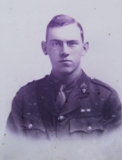
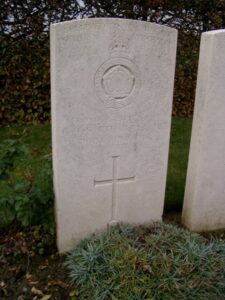
Arthur Llewellyn Thomas, Sapper, 43178, Royal Engineers. Arthur was born in 1894, the only son of William Thomas and Martha Thomas (nee Charles), of 26, Dew Street, Haverfordwest. After leaving Haverfordwest Grammar School he enlisted in the town into the Royal Engineers, and was posted to the 75th Field Company, Royal Engineers, which was attached to the Guards Division. The Division was formed in France in August 1915, from the various Guards units that had been with other Divisions. It remained on the Western Front throughout the war and saw its first major action during the Battle of Loos on 25 September 1915, remaining in the area during the coming months, where they also fought in the subsequent Action of Hohenzollern Redoubt. In July 1916 the Division moved to the Somme, where they fought at the Battle of Flers-Courcelette, and then at the Battle of Morval, capturing Lesboeufs Village. They remained here for the winter, and in March 1917 took part in the advance caused by the German Retreat to the Hindenburg Line. Later that year they moved north to Ypres, taking up positions north of Boesinghe, on the Yser Canal. Arthur was killed during a trench raid on 3 July 1917, aged 23. He is commemorated on the Ypres (Menin Gate) Memorial, Belgium.
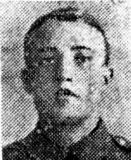
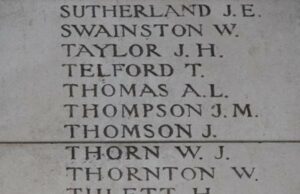
Hugh Ince Webb-Bowen, Captain, Royal Welsh Fusiliers. Hugh was born on 12 February 1878, the eldest son of Thomas Ince Webb-Bowen, late Chief Constable of Pembrokeshire, and Ellen Webb-Bowen (nee Brenchley), of Tenby. He was educated at Haverfordwest Grammar School, before studying law and was admitted to the Bar in 1889. Hugh played rugby for London Welsh as a young man, before enlisting into the army, gaining a commission as Second Lieutenant into the Royal Welch Fusiliers and was drafted to South Africa in 1900 to join the 1st Battalion, Royal Welch Fusiliers, taking part in the Anglo-Boer War, where he gained a reputation for his gallantry. Hugh remained in the army after the war but was seconded to the South African Constabulary for three years before re-joining his regiment in India. Soon after his arrival he was made Adjutant. He was then transferred to the Head Quarter’s Staff of the Egyptian Army and was stationed at Khartoum, but in July 1914 returned to England and married Evelyn Flora Abercromby McDougal in Kensington on 18 July 1914. The couple were still on honeymoon when war broke out and Hugh was recalled to Khartoum. Evelyn joined him there soon afterwards, but by then the war on the Western Front had stagnated into static trench warfare, so the Allies, at the behest of Winston Churchill, came up with the idea of opening another front in an attempt to take Turkey out of the war. The initial plan was to force the Dardanelles Straits by use of a combined Anglo-French fleet, but severe losses were suffered from mines, so on 25 April 1915 the Allied landed on the Gallipoli Peninsula, intending on crossing over the land and capturing Constantinople. As part of the build up to this invasion, Hugh was despatched to the Mediterranean to join the Head Quarters Staff, landing after the initial infantry assault. He was sadly wounded on Gallipoli during the early stages of the campaign there and died of wounds on 24 May 1915. The 37-year-old is buried in Lancashire Landing Cemetery, Gallipoli. He is also commemorated on the St. Martin of Tours war memorial at Haverfordwest.
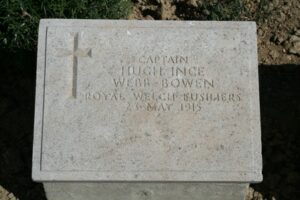
John Lloyd Williams, Private, 2841, Kings Liverpool Regiment. John was born in 1888, the son of George Williams and Jane Williams (nee Allen), of 2, Castle Square, Haverfordwest. Upon leaving Haverfordwest Grammar School he trained as a schoolteacher at Carmarthen Training College and was teaching at Liverpool Sailors Orphanage when war broke out. John enlisted at Liverpool into the 6th Battalion, Kings Liverpool Regiment on 9 November 1914. The battalion landed in France on 25 February 1915, and joined 15 Brigade, 5th Division at Bailleul. On 18 November 1915 the Battalion moved to Third Army Troops, and on 26 January 1916 moved to 165 Brigade, 55th (West Lancashire) Division. The Division relieved the French 88th Division south of Arras, where it took part in many raids and minor operations. Relieved by the 11th (Northern) Division on 25 July, the Division moved south and took up a place in the front line at Maltzhorn Farm, opposite the village of Guillemont, taking part in the Battle of Guillemont and the Battle of Ginchy. On 8 August 1916 John’s battalion launched an assault against the German lines facing Maltzhorn Farm, advancing the front line some 200 yards. John was wounded here, and died of his wounds on the following day, 9 August 1916. The 27-year-old is buried in Guillemont Road Cemetery, Guillemont, France.
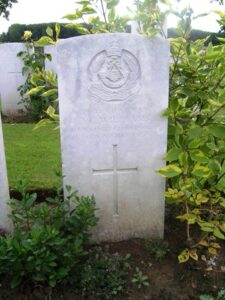
—————————————————————————————————————————————-
World War Two, 1939-1945
Harry Brown Barr, Chief Engineer, Merchant Navy. Harry was a Scotsman, from Leith, who had moved to Pembrokeshire after going to sea with the Merchant Navy and set up home at 33, Church Street, Haverfordwest. He served aboard the Fishing Vessel Respondo, which was registered at Hartlepool. Harry died when Respondo was lost with all hands while fishing off the Irish Coast on 10 September 1940. He was 39 years old, and is commemorated on the Tower Hill Memorial, London.
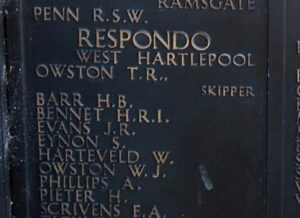
Phillip John William Cole, Seaman, LT/X 19979A, Royal Naval Patrol Service. Phillip served with the Royal Naval Patrol Service aboard HM Trawler Loch Inver. She was a trawler, which had been requisitioned by the Admiralty in October 1939 and converted to an auxiliary patrol vessel, based at Harwich. Phillip lost his life when Loch Inver was sunk by a mine off Harwich on 22 September 1940, with the loss of fourteen men. All her crew are commemorated on the Lowestoft Naval Memorial, England.
Felix Creaney, Rifleman, 7011620, Royal Ulster Rifles. Felix was the son of John and Mary J. Creaney, of Lurgan, Co. Armagh, Northern Ireland, and the husband of Dilys E. Creaney, of Haverfordwest. He served with the 2nd Battalion, The London Irish Rifles. The battalion fought in North Africa, before taking part in the invasion of Sicily and Italy in 1943. Felix was killed in Sicily on 12 August 1943. He was 29 years old, and is buried in Catania War Cemetery, Sicily.
Arthur Hall Davies, Fireman and Trimmer, Merchant Navy. Arthur was born at Haverfordwest in September 1894. He served with the Merchant Navy as Fireman aboard the SS Trewellard, a London registered steamer. On 5 November 1940, Trewellard was part of Convoy HX-84 when it was discovered by the mighty German pocket battleship admiral Scheer. Scheer sank Jervis Bay, and the convoy, escorted only by several ageing destroyers, scattered. Scheer pursued Trewellard, and the outmatched steamship was soon overtaken and sunk by the Scheer, going down with the loss of 14 men. Arthur was one of the dead. He was 46 years old, and is commemorated on the Tower Hill Memorial, London.
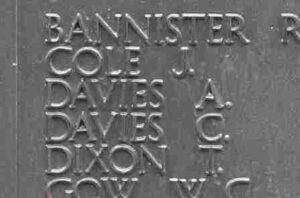
C. T. Davies, Battery Sergeant Major. Cannot presently be identified.
Cyril Edward Evans, Private, T/50674, Royal Army Service Corps. Cyril was born at Haverfordwest in June 1912. He served during World War Two with the Royal Army Service Corps. Little else is known of Cyril, but he died on 16 July 1941, aged 29, and is buried in Pontypridd (Glyntaff) Cemetery, Wales.
Dennis George Finn, Gunner, 89033, Royal Artillery. Dennis was the son of William and Ada Finn, of Haverfordwest. He served with the local Territorial unit, the 102 (The Pembroke Yeomanry) Field Regiment, Royal Artillery. Dennis died on home service at Newton Abbott on 24 January 1942. He is buried in Haverfordwest (City Road) Cemetery.
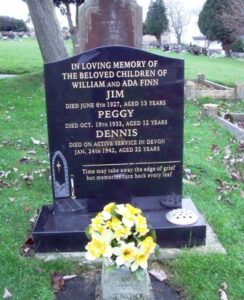
George Arthur Gordon, Seaman, LT/JX 221383, Royal Naval Patrol Service. George was the son of Ernest Edward and Eva Mabel Gordon, of Haverfordwest, and served with the Royal Naval Patrol Service, aboard HM Trawler Ellesmere. She had been requisitioned by the Royal Navy in 1939 and converted for anti submarine use. George was killed when Ellesmere was sunk by the German submarine U-1203 on 24 February 1945. He was 23 years old, and is commemorated on the Lowestoft Naval Memorial, Suffolk.
Michael Francis Headley, Pilot Officer, J/86267, Royal Canadian Air Force. Michael was born in Oliver, British Columbia, Canada on 19 August 1923, the son of Harold Ind Headley and Esme Violet Headley (nee Curwen). His father had emigrated to Canada from Haverfordwest, but after Michael’s birth had returned to his hometown with the family, settling at The Castle Hotel, Haverfordwest. Michael was educated at Milford Haven County School and then at Haverfordwest Grammar School, before leaving Wales to take up a position as a ledger keeper for the Bank of Commerce, Salmon Arm, British Columbia in June 1940. He enlisted into the Royal Canadian Air Force on 8 October 1941 and after completing his training embarked from New York on 22 November 1942 for England, where he carried out further training as a Pilot, before joining 102 Squadron, Royal Air Force at RAF Pocklington on 2 December 1943. On the night of 21 January 1944, Michael took off from Pocklington at the controls of a Handley Page Halifax II, Serial JN952, as part of a large bomber force despatched to destroy targets in Magdeburg. Michael, together with four other crewmen, were killed when their Halifax was shot down and then blew up near Eindhoven, Holland on the following morning, 22 January 1944. Two of the crewmen managed to bale out and survived. Michael was 20 years old when he was killed that morning and is commemorated on the Runnymede Memorial, Surrey.


George Alexander Brockhurst Higgins, Sapper, 2121087, Royal Engineers. George was born on 25 July 1919, the son of John Higgins and Edith Rosina Higgins (nee Brockhurst), of 13, Canada Road, Llandaff, Cardiff. By 1939 the family was residing at 11, Scolton Villas, Haverfordwest and George was studying at Haverfordwest Grammar School. He enlisted into the Royal Engineers and was posted to 688 Artisan Works Company, Royal Engineers. Little else is known of him, but he died as a result of an accident whilst on active service in Newport, Monmouthshire on 15 January 1941. The remains of the 21-year-old were brought home, and he was buried in Haverfordwest (City Road) Cemetery.
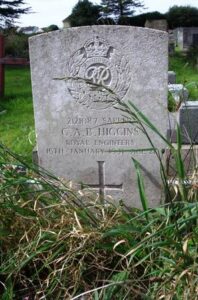
James John Hughes, MID, Pilot Officer, 131806, Royal Air Force Volunteer Reserve. James was the son of Abel and Florence Hughes, of Haverfordwest, and served with 405 Squadron, Royal Air Force. The squadron was a heavy bomber unit, equipped with the Avro Lancaster, based at RAF Topcliffe in 1942. James died when his Lancaster was lost during a raid on 28 June 1942. He was 31 years old, and is commemorated on the Runnymede Memorial, Surrey.
Peter Stanley John, Signalman, 3971731, Royal Corps of Signals. Peter was the son of Peter and Elizabeth John, and the husband of Minnie Anne John, of Haverfordwest. He served with the Royal Corps of Signals, and was posted to India where he became attached to the Indian Signal Corps. Peter died in India on 4 July 1914. He was 27 years old, and is buried in Kirkee War Cemetery, India.
Iorwerth Jones, Private, 3969349, Durham Light Infantry. Iorwerth was born at Clydach Vale in 1913, the son of John Jones and Martha Ann Jones (nee Griffiths). His parents were from Pembrokeshire, but had moved to Merthyr Vale for work in the years leading up to the Great War. Prior to the war he resided at 26b, North Crescent, Haverfordwest. He served with the 16th Battalion, Durham Light Infantry. The battalion formed in Edinburgh in July 1940, and sailed from Liverpool on Christmas Day 1942 aboard the MV Staffordshire, as part of 139 Brigade, 46th Infantry Division, for Tunisia. After the fall of the Axis troops in North Africa, the battalion took part in the Salerno Landings of September 1943, and the subsequent campaign in Italy. Iorwerth was killed in Italy on 13 September 1944, aged 31. He is buried in Coriano Ridge War Cemetery, Italy. A brother, William David Jones, had been killed in Palestine in 1939.
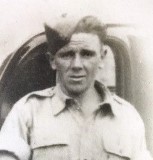
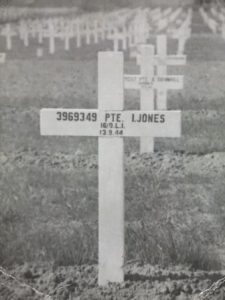
Reverend Harold Samuel Jones, Chaplain 4th Class, 104052, Royal Army Chaplains’ Department. Harold was the son of John and Mary Jane Jones, and the husband of Lilian Louisa Jones, of Haverfordwest. He served as a Chaplain in the Army, and was based in Greece during the German invasion in 1941. Harold was killed during the evacuation of Greece on 24 April 1941. He was 39 years old, and is commemorated on the Athens Memorial, Greece.
William David Jones, Corporal, 3956533, Welch Regiment. William was born at Clydach Vale in 1909, the son of John Jones and Martha Ann Jones (nee Griffiths). His parents were from Pembrokeshire, but had moved to Merthyr Vale for work in the years leading up to the Great War. William married Marjorie Violet Croucher at Gosport, Hampshire in 1932 and the couple had four children born over the coming years. He was a regular soldier, having enlisted at sometime prior to the war, and served with the 1st Battalion, Welch Regiment. In April 1939 the battalion left Southampton for Palestine aboard the troopship Somersetshire, together with the 1st Argyll & Sutherland Highlanders, and at Gibraltar picked up the 1st Welsh Guards. The three battalions then disembarked in Palestine for peacekeeping duties, following the Arab Revolt of 1936, as part of the 6th Division. On the day after they disembarked, the 1st Welch became involved in several skirmishes against Arabs near Safad, before seizing the village of Safsaf, near the northern border. William survived several of these skirmishes against the Arabs over the coming months, but sadly drowned at Nathanya on 22 October 1939, in unknown circumstances. The 30-year-old was buried in Ramleh War Cemetery, Israel. One of his brothers, Iorwerth, was killed in Italy in 1943, whilst his widow, Marjorie, lost a brother, George Robert Frederick Croucher, who was killed with the loss of HMS Panther in 1943.
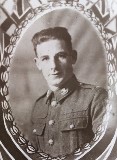
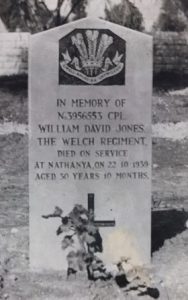
Albert Gordon Laugharne, B.A., Sub-Lieutenant, Royal Naval Volunteer Reserve. Albert was the son of Albert and Rose Laughame, of Haverfordwest, and the husband of Rosamond Mair Laughame, of Ammanford. He served in the RNVR aboard H.M.S. Blackwood, which was an American Lend-Lease Destroyer that had been taken over by the Royal Navy on 27 March 1943. After over a year spent carring out escort duties with the Atlantic Convoys Blackwood was torpedoed by U-764 off Portland Bill on 15 June 1944, and sank the next day under tow. Albert was killed in the initial torpedo strike and was 27 year old. He is commemorated on the Plymouth Naval Memorial.
Cyril Thomas William Leman, Leading Aircraftman, 951530, Royal Air Force Volunteer Reserve. Cyril was the son of Montagu William and Ethel Maude Leman, Of Haverfordwest. He served with the Royal Air Force Volunteer Reserve. Cyril was listed as Died on Active Service on 31 August 1940. He was 23 years old, and is buried in Haverfordwest (City Road) Cemetery.
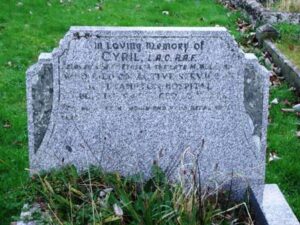
Henry Victor Lewis, Serjeant, 7598283, Royal Electrical And Mechanical Engineers. Henry was the son of David Henry and Edith Lewis of Cartlett, Haverfordwest. He served with the Royal Electrical and Mechanical Engineers during the war. Henry died on 4 January 1944. He was 38 years old, and is buried in Haverfordwest (City Road) Cemetery.
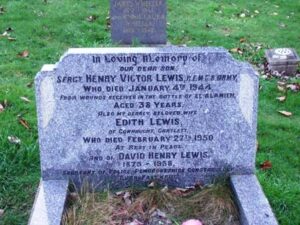
Leonard George Phillips Owen, Private, 6108354, Parachute Regiment. Leonard was born on 19 June 1924, the son of William Douglas Owen and Violet Yvonne Owen (nee Phillips), of 2, Gloucester Terrace, Haverfordwest. Upon completing his education at Haverfordwest Grammar School, Leonard enlisted into the army and was posted to the 13th Battalion, Royal Warwickshire Regiment. Early in 1943 the battalion was converted into the 8th Battalion, Parachute Regiment, which became attached to the 3rd Parachute Brigade, 6th Airborne Division. The brigade first went into action on 5 June 1944 during Operation Tonga, part of the Normandy landings, its objective being to destroy the Merville Gun Battery and the bridges over the River Dives. The brigade defended the left flank of the invasion zone until mid-August, when it joined the advance before being relieved and returned to England to refit. The brigade was moved to Belgium in December 1944, to counter the German attack in the Ardennes, and remained on the Belgian/Dutch border for three months until taking part in Operation Varsity, the crossing of the River Rhine in Germany. Leonard was killed during this major operation, during the crossing of the River Rhine on 28 March 1945. He was 20 years old, and is buried in Reichswald Forest War Cemetery, Germany.
Francis Henry Perrins, Craftsman, 7597122, Royal Electrical And Mechanical Engineers. Francis was the son of Jack and May Perrins, of Haverfordwest, and served with the Royal Electrical and Mechanical Engineers. He was stationed at Windsor when he died on active service on 5 December 1943. Francis was 19 years old, and is buried in Windsor Cemetery, Berkshire.
Cecil Charles Reidmuller, Sergeant (Wireless Operator/ Air Gunner), 979560, Royal Air Force Volunteer Reserve. Cecil was born on 9 February 1918, the son of Auguste Charles Reidmuller and Emma Mary Elizabeth Reidmuller (nee Cecil), of Camden, London. He lodged with his aunt, Miss Gladys Agatha Cecil, at 4, High Street, Haverfordwest for several years whilst being educated at Haverfordwest Grammar School. Cecil enlisted into the Royal Air Force Volunteer Reserve after leaving school and trained as a Wireless Operator/ Air Gunner before being posted to 149 Squadron, Royal Air Force, which was a bomber squadron, equipped with the Vickers Wellington and based at RAF Mildenhall. On the night of 1 July 1941, Cecil took off from Mildenhall aboard a Vickers Wellington IC, Serial R1343, which joined a large bomber force despatched to strike targets in Brest. Cecil was killed when his Wellington was brought down over France on the following morning, 2 July 1941. The 23-year-old is buried at Brest (Kerfautras) Cemetery, France.
William Raymond Reynish, Private, 14584269, The Hampshire Regiment. William was the son of George and Beatrice Reynish, of Haverfordwest, and the husband of Ethel Reynish, of Bearwood, Smethwick, Staffordshire. He served with the 1/4th Battalion, Hampshire Regiment, which was attached to 128 Infantry Brigade. The brigade fought in North Africa, then in the invasion of Sicily and Italy from 1943. William was killed in Italy on 6 December 1944. He was 28 years old, and is buried in Forli War Cemetery, Italy.
Frederick Albert Waite, Fireman and Trimmer, Merchant Navy. Frederick was born at Brecon on 28 March 1924, the son of William Edward Waite and Margaret Ann Waite (nee Francis). By 1929 the family had moved to Crundale Hall, Haverfordwest and then later to Lansdowne House, 8, Dew Street, Haverfordwest. Frederick was educated at Haverfordwest Grammar School but enlisted into the Merchant Navy soon after the outbreak of war. He was posted aboard the SS Fort Babine, a London registered cargo vessel. On 6 February 1943, Fort Babine was in the Mediterranean, steaming from Newport for Algiers, when she was attacked by German aircraft and damaged by an aerial torpedo. The stricken ship was towed to Oran and temporarily repaired at Gibraltar. Frederick was killed by enemy action during that attack, on 6 February 1943. The 18-year-old is buried in Le Petit Lac Cemetery, Algeria.